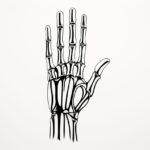
Drawing hands can be one of the most complex challenges an artist faces. The intricacies of the human hand, with its multitude of angles, proportions, and expressive potential, can seem daunting, especially when capturing them in dynamic poses. Each hand is a masterpiece in itself, and when positioned in various stances, they tell powerful stories and evoke distinct emotions. In this article, we aim to simplify an often tricky subject by honing in on a specific pose—hands on hips. This common yet expressive stance is not only prevalent in art but also in everyday life, allowing us to explore both structure and attitude.
By dissecting this pose step-by-step, you will learn how to draw hands on hips with confidence and precision. Whether you’re a beginner looking to improve your skills or an experienced artist seeking to refine your techniques, this guide will provide you with the tools needed to accurately depict hands on hips. We’ll start by understanding the foundational structure of the hand before gradually advancing to more intricate details, ensuring you can tackle this pose with ease.
So, grab your drawing materials and prepare to dive into the world of hands on hips. As we walk through each stage, you’ll not only enhance your artistic abilities but also gain a deeper appreciation for the expressive power of hands. Let’s embark on this creative journey together and unlock the potential of your artistic skills!
Materials Required
Before we begin, gather the following materials:
- Drawing paper
- Pencil (HB or 2B)
- Eraser
- Ruler (optional)
- Reference images of hands on hips (optional)
Step 1: Understand the Structure of the Hand
To accurately draw hands on hips, it is important to have a solid understanding of the hand’s basic structure. The hand consists of the palm and fingers, with each finger comprising three phalanges, except for the thumb, which has two. Familiarize yourself with the various joints and how they move to create different hand poses.
Step 2: Start with Basic Shapes
Begin by lightly sketching a rectangle for the palm of the hand. This will serve as the foundation for the rest of the hand. Then, add a rough triangle shape on top of the rectangle to represent the base of the thumb.
Step 3: Outline the Fingers
Next, draw elongated shapes for the fingers extending from the palm. Remember that the fingers are slender and taper towards the tips. Use light, curved lines to define the shape of each finger.
Step 4: Add Details to the Thumb
Focus on the thumb by adding more definition to its shape. Observe how the thumb connects to the palm and curves slightly towards the other fingers. Refine the triangular shape created earlier, ensuring it looks natural and proportional.
Step 5: Sketch the Hand on Hips Pose
Now that you have a basic framework, it’s time to position the hand on the hips. Imagine the hand resting comfortably on the waistline with the fingers overlapping. Use light, loose lines to outline the overall shape of the hand in this pose.
Step 6: Refine the Hand Shape
With the main pose in place, start refining the shape of the hand. Pay attention to the curves and angles of the palm and fingers. Adjust the lines as necessary to achieve a more accurate representation.
Step 7: Define the Fingers
Focus on each finger individually, adding more definition to their shapes and lengths. Observe how they overlap slightly and how the knuckles create subtle bumps on the back of the hand.
Step 8: Refine the Thumb
Refine the shape of the thumb, ensuring it looks natural and proportional to the rest of the hand. Pay close attention to the joint at the base of the thumb, which connects it to the palm.
Step 9: Add Details and Texture
Now that the basic hand shape is complete, it’s time to add finer details and texture. Study the reference images or your own hand to observe any unique features, such as wrinkles, lines, or creases. Incorporating these elements will add depth and realism to your drawing.
Step 10: Finalize the Drawing
Take a step back and assess your drawing as a whole. Make any necessary adjustments to ensure the hand looks balanced and proportional. Erase any extraneous guidelines, and darken the lines to give your drawing a finished appearance.
Mistake Alert: One common pitfall when drawing hands on hips is neglecting the perspective of the elbows and shoulders, which can lead to an unnatural and stiff appearance. This mistake often occurs because artists focus primarily on the hands, forgetting that the arms and upper body should create a cohesive flow. To avoid this, always start by sketching the entire arm from the shoulder to the wrist, paying close attention to the angle and positioning of the elbows. Remember that the elbows should typically be aligned with the hips, creating a relaxed and dynamic pose. By maintaining this awareness of overall body alignment, your drawing will feel more lifelike and expressive.
Conclusion
Drawing hands on hips can be a challenge, but with practice and patience, you can master this pose. By understanding the basic structure of the hand, starting with simple shapes, and gradually adding details, you’ll be able to create realistic and expressive hands on hips in your artwork. Remember to reference images or even your own hands for accuracy and to incorporate unique features. With these step-by-step instructions, you’re well on your way to becoming a skilled artist in capturing hands on hips.
Fun Facts About Hands on Hips
- The “hands on hips” pose is also known as “akimbo,” a term that dates back to the Middle Ages.
- This stance is often associated with assertiveness, confidence, or authority in both art and everyday life.
- Studies suggest that standing with hands on hips can temporarily boost your confidence and even increase feelings of power.
- The pose is commonly used in dance as a starting or resting position, often adding flair and attitude.
- In superhero comics and movies, characters often stand with their hands on their hips when striking a powerful pose or preparing for action.
- Anthropologists suggest the hands on hips pose might have evolved as a way to make oneself appear bigger or more intimidating.
- This posture is frequently used by athletes as a way to catch their breath, as it can open up the chest and make breathing easier.
- Some ancient sculptures and paintings show figures with hands on hips, demonstrating that it’s a timeless pose.
- While generally interpreted as a sign of confidence, context matters; in some settings, it can also be read as a sign of impatience or defiance.
- In yoga, placing hands on hips can help in maintaining balance and aligning the spine during certain poses.
Suggestions for Scenes and Settings for Hands on Hips Drawings
- Superhero Stance: Draw a dynamic scene of a superhero surveying the cityscape, hands on hips, cape fluttering in the breeze behind them.
- Dance Performance: Illustrate a lively group dance routine where dancers strike a pose with their hands on hips, capturing a moment of energy and grace.
- Soccer Captain: Create a vibrant sports scene with a team captain standing hands on hips, rallying their team on the field.
- Fashion Show Runway: Show a model at the end of a catwalk, pausing with hands on hips to strike a confident pose in an avant-garde outfit.
- Medieval Knight: Imagine a bold knight in shining armor standing amidst a bustling marketplace, hands on hips, surveying the scene.
- Children’s Stand-off: Depict a group of kids in a playground, one standing with hands on hips as they negotiate turn-taking for the swings.
- Puppet Theater: Draw a whimsical puppet with an exaggerated hands-on-hips stance, commanding the tiny stage with charisma.
- Artistic Muse: Illustrate an artist’s studio where the subject of a portrait stands with hands on hips, challenging the viewer with their gaze.
- Modern Office: Photorealistically capture a busy office scene, focusing on a confident executive standing hands on hips while leading a presentation.
- Construction Site: Imagine a foreman at a bustling building site, hands on hips, directing workers and checking blueprints against the emerging structure.









